economics. Contents. Introduction......................
VerifiedAdded on 2023/04/20
|13
|2736
|417
AI Summary
Contribute Materials
Your contribution can guide someone’s learning journey. Share your
documents today.
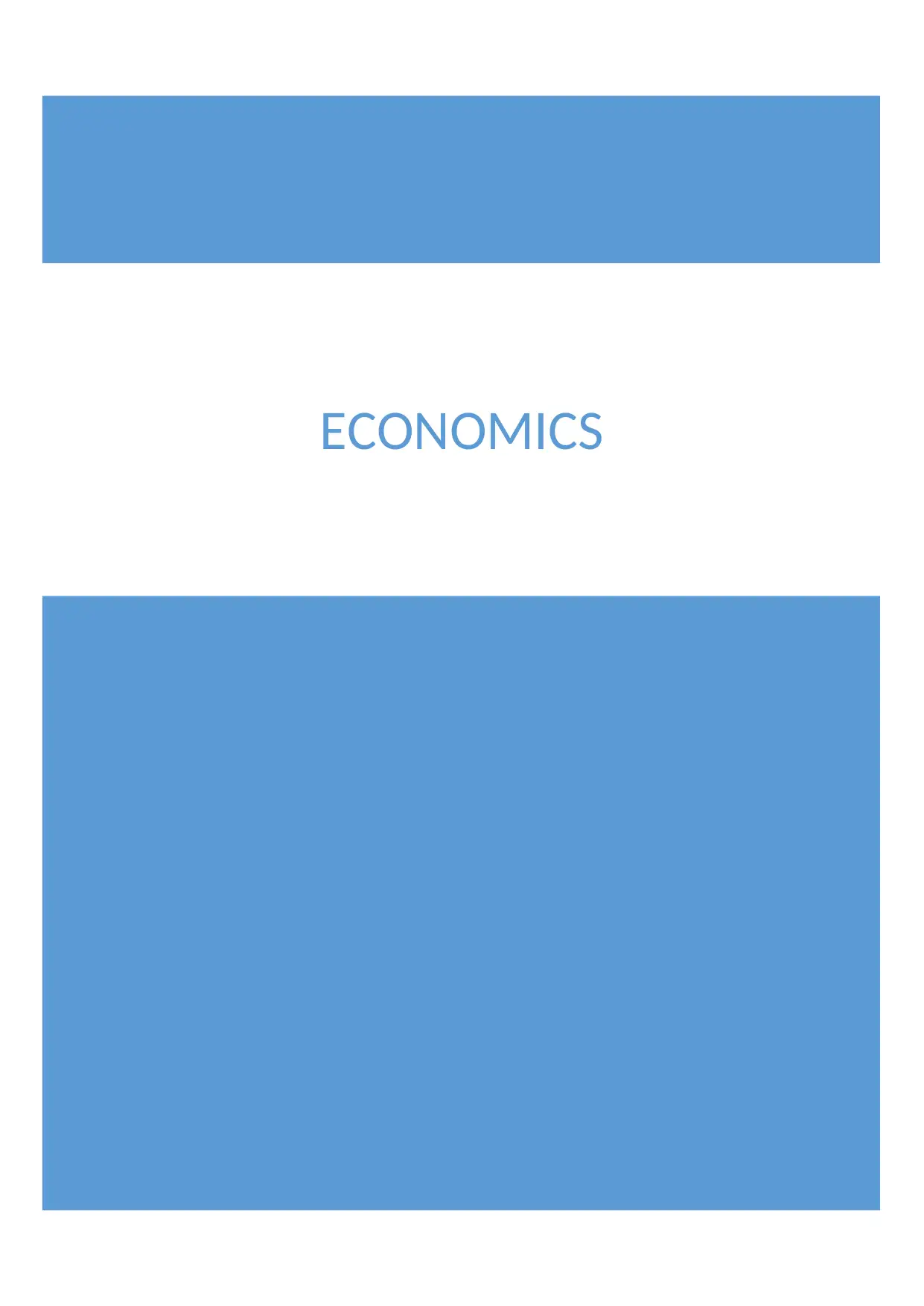
ECONOMICS
Secure Best Marks with AI Grader
Need help grading? Try our AI Grader for instant feedback on your assignments.
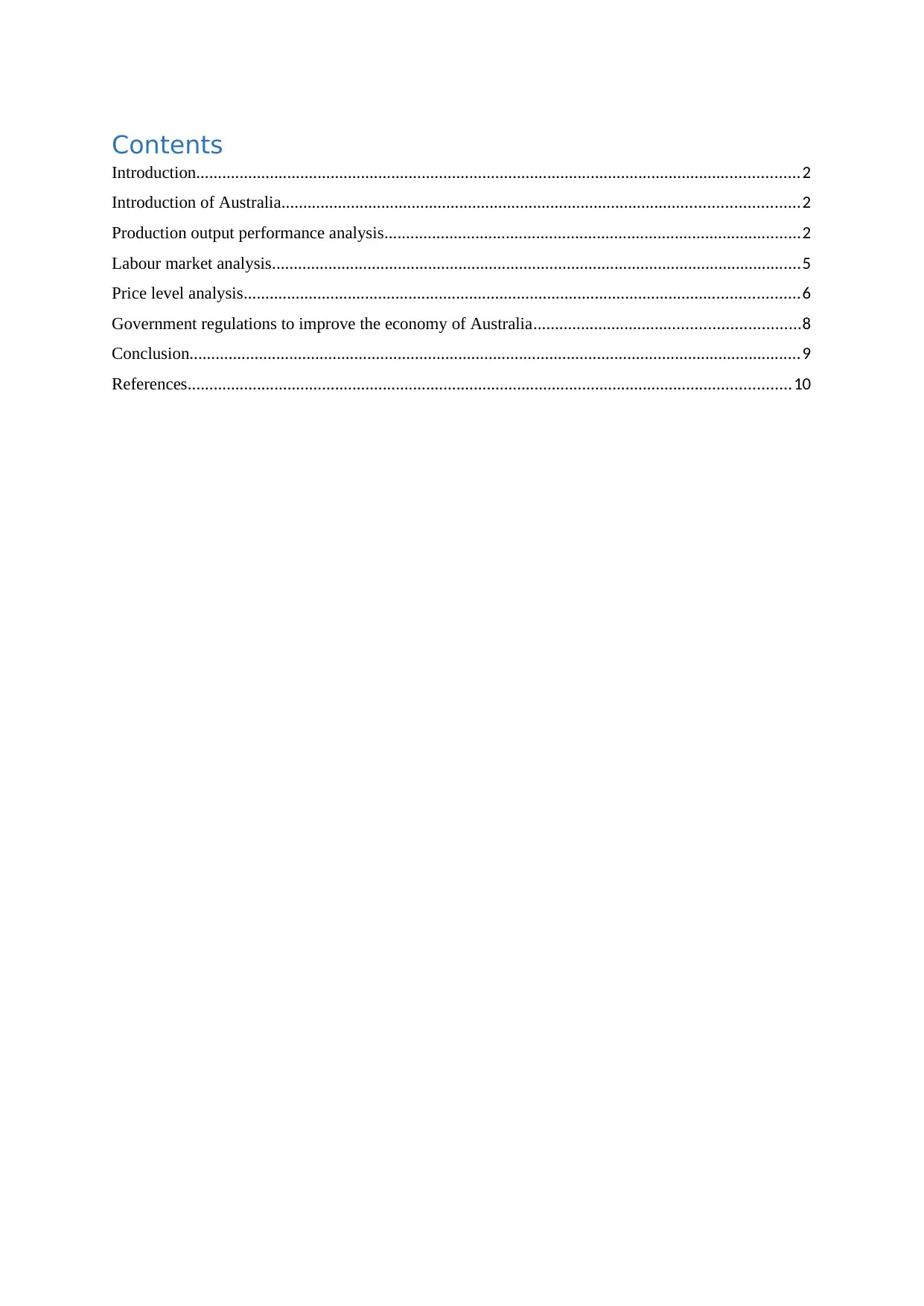
Contents
Introduction...........................................................................................................................................2
Introduction of Australia.......................................................................................................................2
Production output performance analysis................................................................................................2
Labour market analysis..........................................................................................................................5
Price level analysis................................................................................................................................6
Government regulations to improve the economy of Australia.............................................................8
Conclusion.............................................................................................................................................9
References...........................................................................................................................................10
Introduction...........................................................................................................................................2
Introduction of Australia.......................................................................................................................2
Production output performance analysis................................................................................................2
Labour market analysis..........................................................................................................................5
Price level analysis................................................................................................................................6
Government regulations to improve the economy of Australia.............................................................8
Conclusion.............................................................................................................................................9
References...........................................................................................................................................10
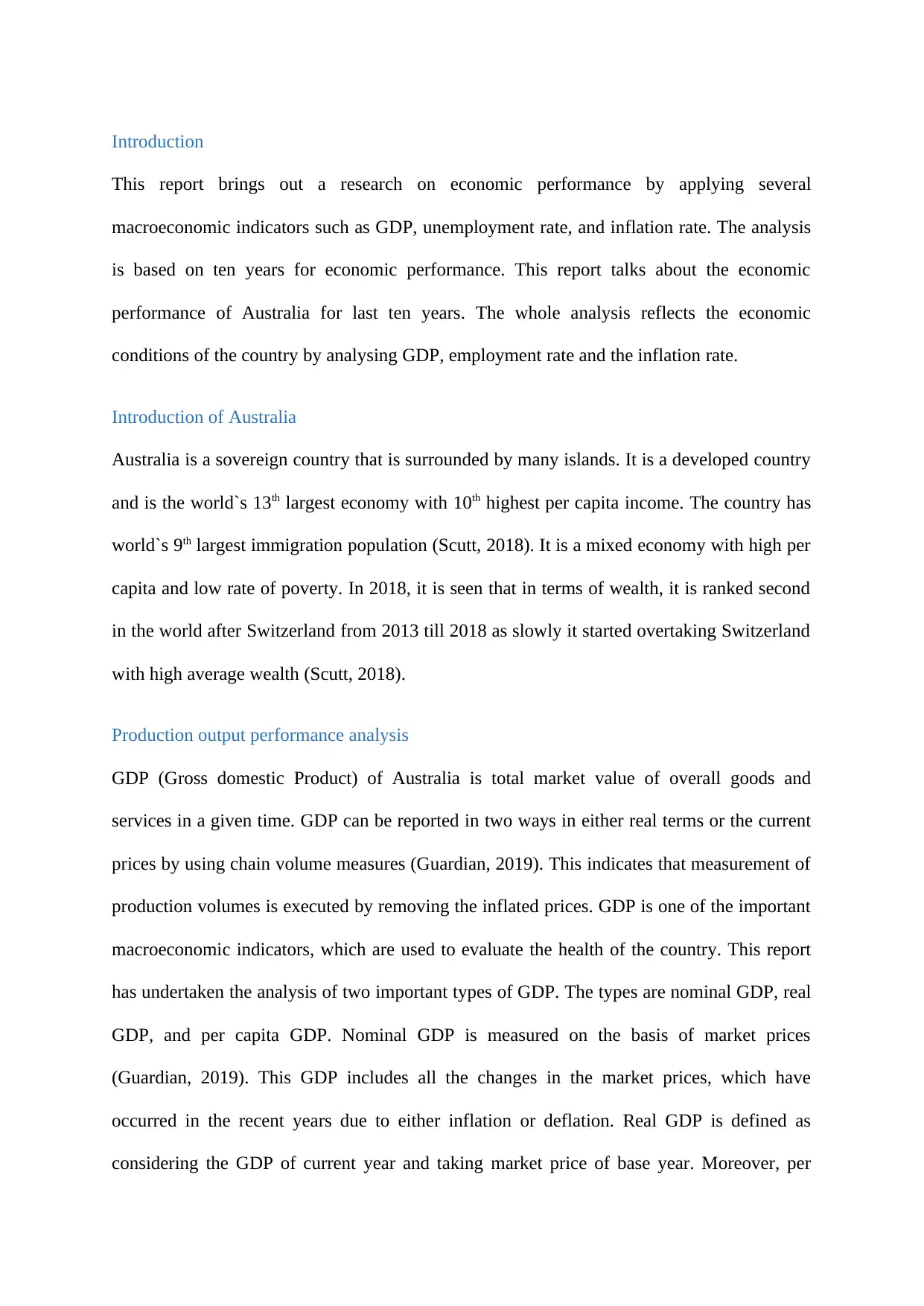
Introduction
This report brings out a research on economic performance by applying several
macroeconomic indicators such as GDP, unemployment rate, and inflation rate. The analysis
is based on ten years for economic performance. This report talks about the economic
performance of Australia for last ten years. The whole analysis reflects the economic
conditions of the country by analysing GDP, employment rate and the inflation rate.
Introduction of Australia
Australia is a sovereign country that is surrounded by many islands. It is a developed country
and is the world`s 13th largest economy with 10th highest per capita income. The country has
world`s 9th largest immigration population (Scutt, 2018). It is a mixed economy with high per
capita and low rate of poverty. In 2018, it is seen that in terms of wealth, it is ranked second
in the world after Switzerland from 2013 till 2018 as slowly it started overtaking Switzerland
with high average wealth (Scutt, 2018).
Production output performance analysis
GDP (Gross domestic Product) of Australia is total market value of overall goods and
services in a given time. GDP can be reported in two ways in either real terms or the current
prices by using chain volume measures (Guardian, 2019). This indicates that measurement of
production volumes is executed by removing the inflated prices. GDP is one of the important
macroeconomic indicators, which are used to evaluate the health of the country. This report
has undertaken the analysis of two important types of GDP. The types are nominal GDP, real
GDP, and per capita GDP. Nominal GDP is measured on the basis of market prices
(Guardian, 2019). This GDP includes all the changes in the market prices, which have
occurred in the recent years due to either inflation or deflation. Real GDP is defined as
considering the GDP of current year and taking market price of base year. Moreover, per
This report brings out a research on economic performance by applying several
macroeconomic indicators such as GDP, unemployment rate, and inflation rate. The analysis
is based on ten years for economic performance. This report talks about the economic
performance of Australia for last ten years. The whole analysis reflects the economic
conditions of the country by analysing GDP, employment rate and the inflation rate.
Introduction of Australia
Australia is a sovereign country that is surrounded by many islands. It is a developed country
and is the world`s 13th largest economy with 10th highest per capita income. The country has
world`s 9th largest immigration population (Scutt, 2018). It is a mixed economy with high per
capita and low rate of poverty. In 2018, it is seen that in terms of wealth, it is ranked second
in the world after Switzerland from 2013 till 2018 as slowly it started overtaking Switzerland
with high average wealth (Scutt, 2018).
Production output performance analysis
GDP (Gross domestic Product) of Australia is total market value of overall goods and
services in a given time. GDP can be reported in two ways in either real terms or the current
prices by using chain volume measures (Guardian, 2019). This indicates that measurement of
production volumes is executed by removing the inflated prices. GDP is one of the important
macroeconomic indicators, which are used to evaluate the health of the country. This report
has undertaken the analysis of two important types of GDP. The types are nominal GDP, real
GDP, and per capita GDP. Nominal GDP is measured on the basis of market prices
(Guardian, 2019). This GDP includes all the changes in the market prices, which have
occurred in the recent years due to either inflation or deflation. Real GDP is defined as
considering the GDP of current year and taking market price of base year. Moreover, per
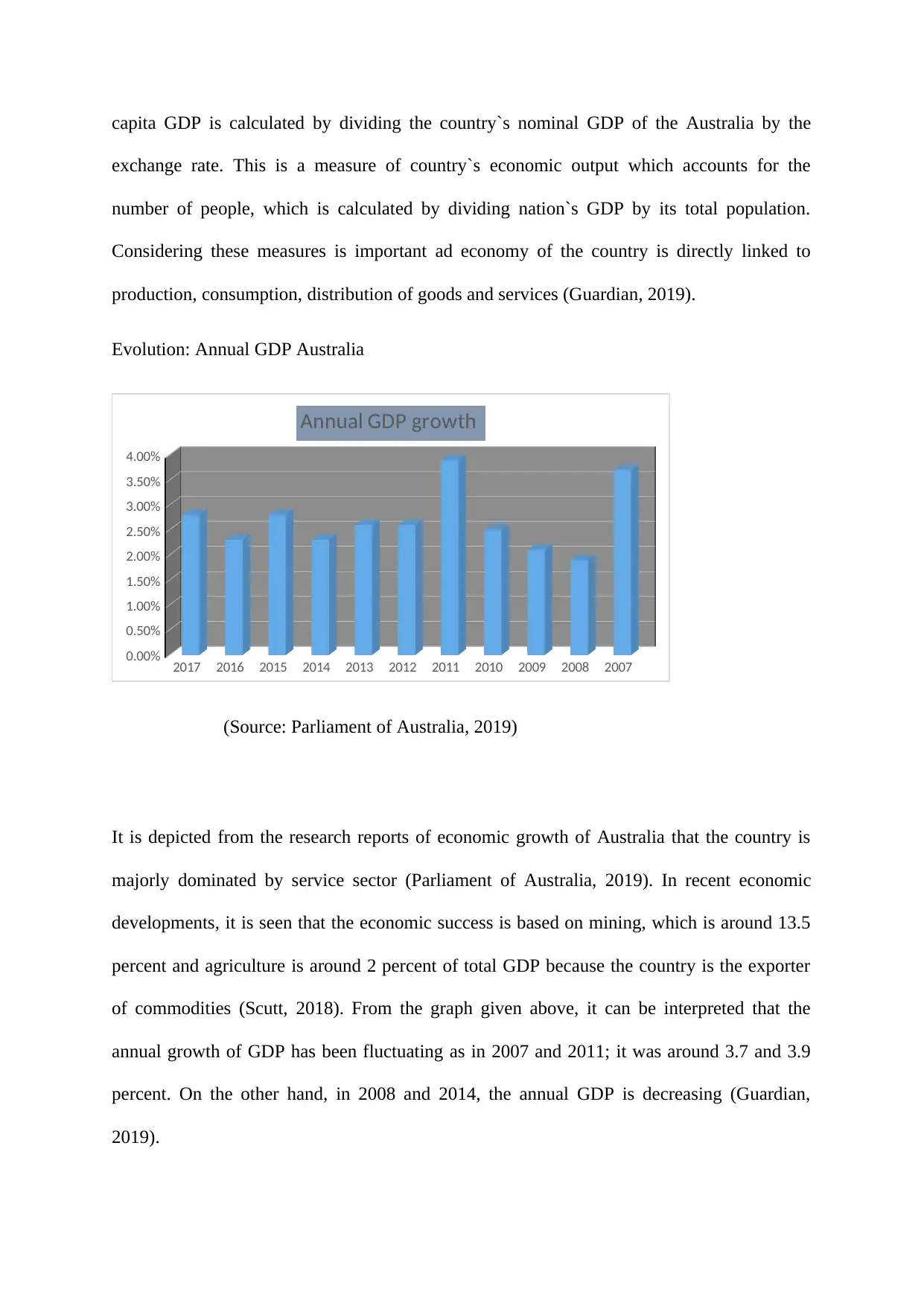
capita GDP is calculated by dividing the country`s nominal GDP of the Australia by the
exchange rate. This is a measure of country`s economic output which accounts for the
number of people, which is calculated by dividing nation`s GDP by its total population.
Considering these measures is important ad economy of the country is directly linked to
production, consumption, distribution of goods and services (Guardian, 2019).
Evolution: Annual GDP Australia
2017 2016 2015 2014 2013 2012 2011 2010 2009 2008 2007
0.00%
0.50%
1.00%
1.50%
2.00%
2.50%
3.00%
3.50%
4.00%
Annual GDP growth
(Source: Parliament of Australia, 2019)
It is depicted from the research reports of economic growth of Australia that the country is
majorly dominated by service sector (Parliament of Australia, 2019). In recent economic
developments, it is seen that the economic success is based on mining, which is around 13.5
percent and agriculture is around 2 percent of total GDP because the country is the exporter
of commodities (Scutt, 2018). From the graph given above, it can be interpreted that the
annual growth of GDP has been fluctuating as in 2007 and 2011; it was around 3.7 and 3.9
percent. On the other hand, in 2008 and 2014, the annual GDP is decreasing (Guardian,
2019).
exchange rate. This is a measure of country`s economic output which accounts for the
number of people, which is calculated by dividing nation`s GDP by its total population.
Considering these measures is important ad economy of the country is directly linked to
production, consumption, distribution of goods and services (Guardian, 2019).
Evolution: Annual GDP Australia
2017 2016 2015 2014 2013 2012 2011 2010 2009 2008 2007
0.00%
0.50%
1.00%
1.50%
2.00%
2.50%
3.00%
3.50%
4.00%
Annual GDP growth
(Source: Parliament of Australia, 2019)
It is depicted from the research reports of economic growth of Australia that the country is
majorly dominated by service sector (Parliament of Australia, 2019). In recent economic
developments, it is seen that the economic success is based on mining, which is around 13.5
percent and agriculture is around 2 percent of total GDP because the country is the exporter
of commodities (Scutt, 2018). From the graph given above, it can be interpreted that the
annual growth of GDP has been fluctuating as in 2007 and 2011; it was around 3.7 and 3.9
percent. On the other hand, in 2008 and 2014, the annual GDP is decreasing (Guardian,
2019).
Secure Best Marks with AI Grader
Need help grading? Try our AI Grader for instant feedback on your assignments.

(Source: CEIC, 2019)
The above graph indicates that nominal GDP of Australia keep fluctuating. Moreover,
according to CEIC, it is reported that the Nominal GDP growth of Australia is seen at 3.85
percent in 2018, which is more than 3.5 percent in 2017. The nominal calculation is updated
quarterly which indicates that average of nominal GDP is 8.154 percent from 1960 to 2018
(Parliament of Australia, 2019). From the above given graph, it can be analysed that in 2007,
the GDP is around 1.27 to 3 percent. In 2008, it lies between 2 to 3 percent. In 2009, the GDP
shown in the above graph reflects that the country was not able to earn due to biggest US
recession in the world. Slowly and steadily, Australia strived to retain its GDP again soon in
2010 (Countryeconomy, 2019). Again, in 2011 and 2016, the graph shows weaker
contradiction and the reason can be that final consumption outlay where non-dwelling
construction and net trade had a negative and negative effect. At last, it is important to
analyse that the GDP of Australia lies between 2 to 3 percent and there is a need to pace up to
reach to 5 to 6 percent (CEIC, 2019). The country is world’s 13th largest economy. The
economic conditions of Australia is stable. The decrease in GDP is due to bad weather that
have slowed down the housing investments and exports related to mining because of
The above graph indicates that nominal GDP of Australia keep fluctuating. Moreover,
according to CEIC, it is reported that the Nominal GDP growth of Australia is seen at 3.85
percent in 2018, which is more than 3.5 percent in 2017. The nominal calculation is updated
quarterly which indicates that average of nominal GDP is 8.154 percent from 1960 to 2018
(Parliament of Australia, 2019). From the above given graph, it can be analysed that in 2007,
the GDP is around 1.27 to 3 percent. In 2008, it lies between 2 to 3 percent. In 2009, the GDP
shown in the above graph reflects that the country was not able to earn due to biggest US
recession in the world. Slowly and steadily, Australia strived to retain its GDP again soon in
2010 (Countryeconomy, 2019). Again, in 2011 and 2016, the graph shows weaker
contradiction and the reason can be that final consumption outlay where non-dwelling
construction and net trade had a negative and negative effect. At last, it is important to
analyse that the GDP of Australia lies between 2 to 3 percent and there is a need to pace up to
reach to 5 to 6 percent (CEIC, 2019). The country is world’s 13th largest economy. The
economic conditions of Australia is stable. The decrease in GDP is due to bad weather that
have slowed down the housing investments and exports related to mining because of
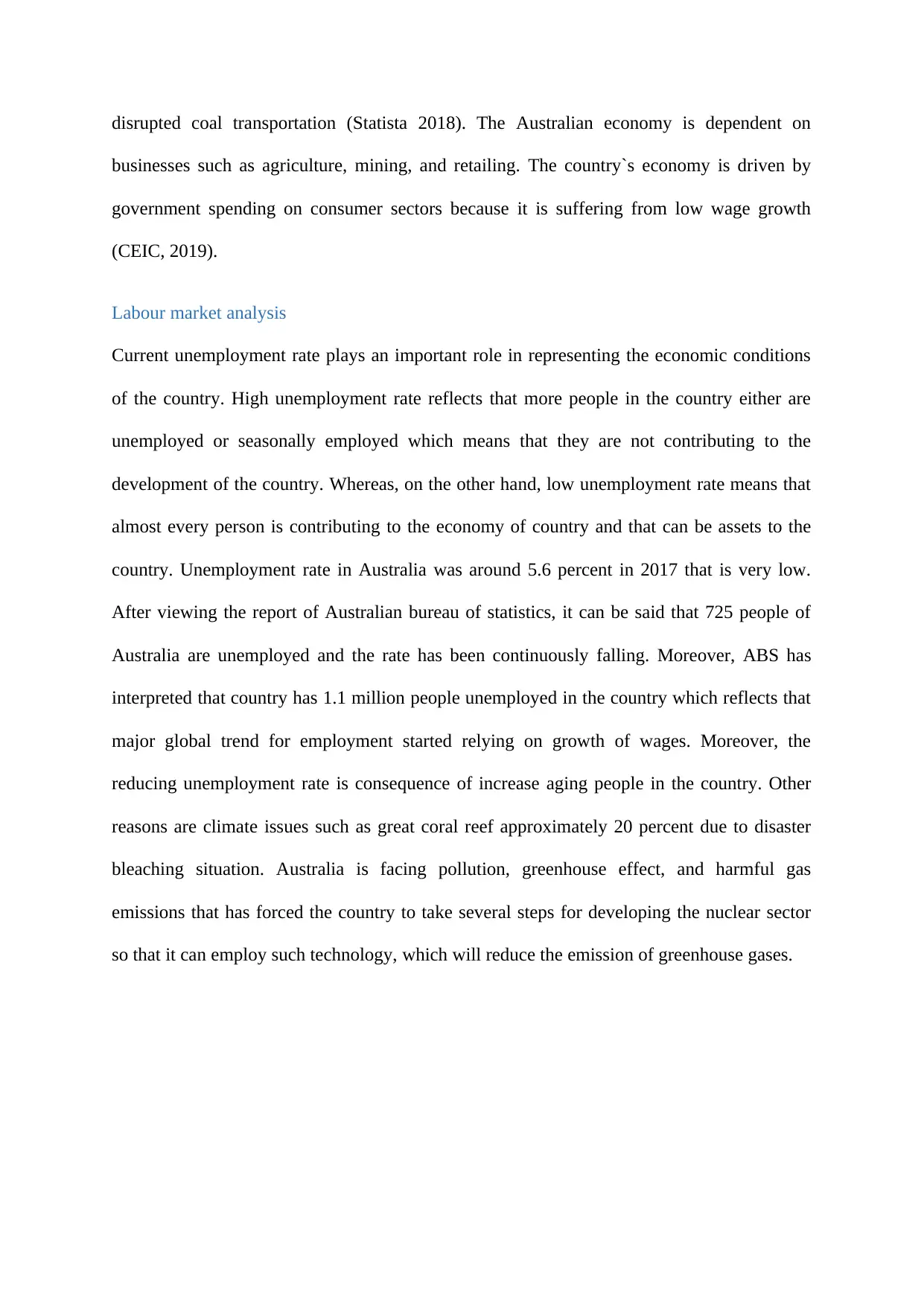
disrupted coal transportation (Statista 2018). The Australian economy is dependent on
businesses such as agriculture, mining, and retailing. The country`s economy is driven by
government spending on consumer sectors because it is suffering from low wage growth
(CEIC, 2019).
Labour market analysis
Current unemployment rate plays an important role in representing the economic conditions
of the country. High unemployment rate reflects that more people in the country either are
unemployed or seasonally employed which means that they are not contributing to the
development of the country. Whereas, on the other hand, low unemployment rate means that
almost every person is contributing to the economy of country and that can be assets to the
country. Unemployment rate in Australia was around 5.6 percent in 2017 that is very low.
After viewing the report of Australian bureau of statistics, it can be said that 725 people of
Australia are unemployed and the rate has been continuously falling. Moreover, ABS has
interpreted that country has 1.1 million people unemployed in the country which reflects that
major global trend for employment started relying on growth of wages. Moreover, the
reducing unemployment rate is consequence of increase aging people in the country. Other
reasons are climate issues such as great coral reef approximately 20 percent due to disaster
bleaching situation. Australia is facing pollution, greenhouse effect, and harmful gas
emissions that has forced the country to take several steps for developing the nuclear sector
so that it can employ such technology, which will reduce the emission of greenhouse gases.
businesses such as agriculture, mining, and retailing. The country`s economy is driven by
government spending on consumer sectors because it is suffering from low wage growth
(CEIC, 2019).
Labour market analysis
Current unemployment rate plays an important role in representing the economic conditions
of the country. High unemployment rate reflects that more people in the country either are
unemployed or seasonally employed which means that they are not contributing to the
development of the country. Whereas, on the other hand, low unemployment rate means that
almost every person is contributing to the economy of country and that can be assets to the
country. Unemployment rate in Australia was around 5.6 percent in 2017 that is very low.
After viewing the report of Australian bureau of statistics, it can be said that 725 people of
Australia are unemployed and the rate has been continuously falling. Moreover, ABS has
interpreted that country has 1.1 million people unemployed in the country which reflects that
major global trend for employment started relying on growth of wages. Moreover, the
reducing unemployment rate is consequence of increase aging people in the country. Other
reasons are climate issues such as great coral reef approximately 20 percent due to disaster
bleaching situation. Australia is facing pollution, greenhouse effect, and harmful gas
emissions that has forced the country to take several steps for developing the nuclear sector
so that it can employ such technology, which will reduce the emission of greenhouse gases.
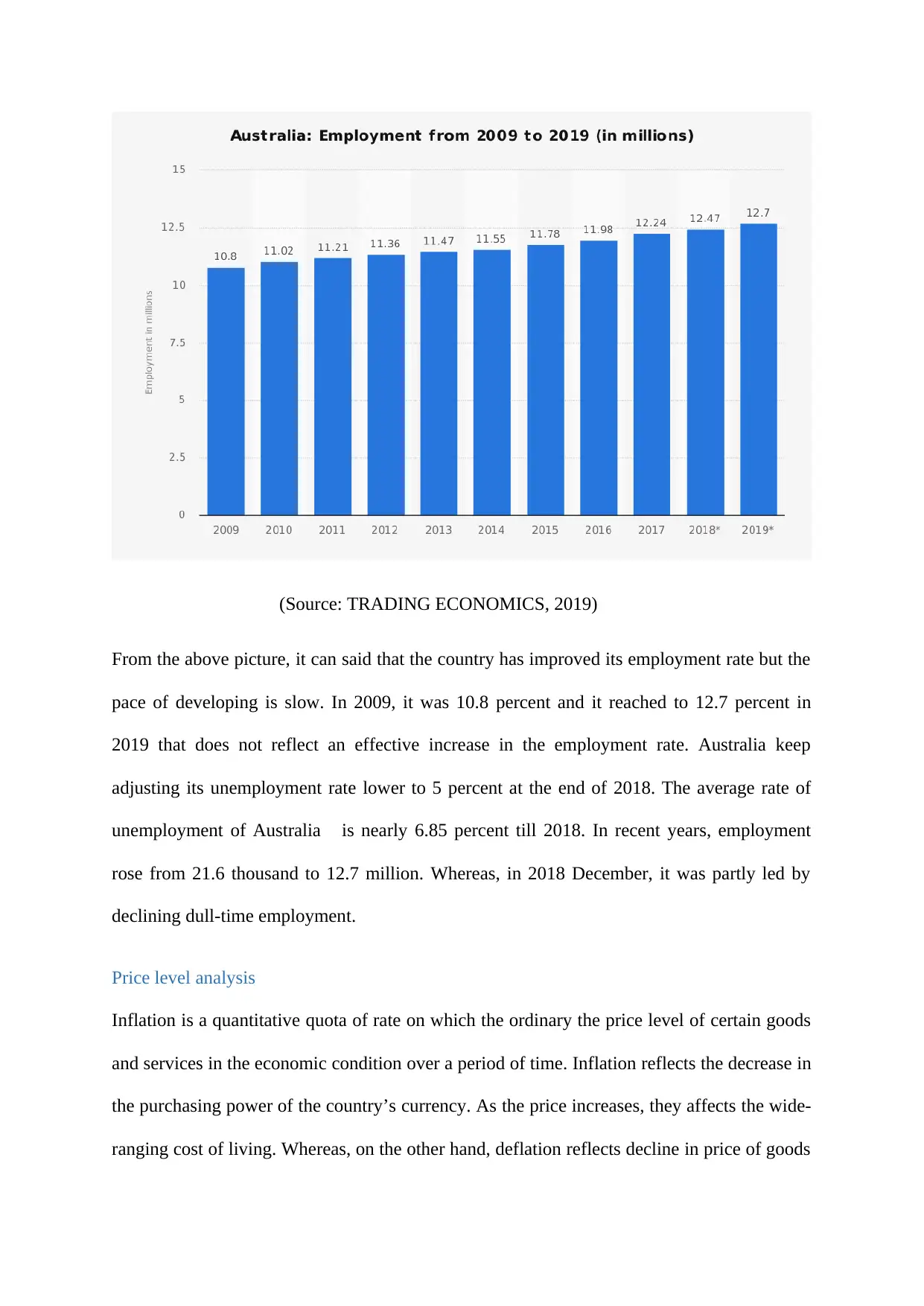
(Source: TRADING ECONOMICS, 2019)
From the above picture, it can said that the country has improved its employment rate but the
pace of developing is slow. In 2009, it was 10.8 percent and it reached to 12.7 percent in
2019 that does not reflect an effective increase in the employment rate. Australia keep
adjusting its unemployment rate lower to 5 percent at the end of 2018. The average rate of
unemployment of Australia is nearly 6.85 percent till 2018. In recent years, employment
rose from 21.6 thousand to 12.7 million. Whereas, in 2018 December, it was partly led by
declining dull-time employment.
Price level analysis
Inflation is a quantitative quota of rate on which the ordinary the price level of certain goods
and services in the economic condition over a period of time. Inflation reflects the decrease in
the purchasing power of the country’s currency. As the price increases, they affects the wide-
ranging cost of living. Whereas, on the other hand, deflation reflects decline in price of goods
From the above picture, it can said that the country has improved its employment rate but the
pace of developing is slow. In 2009, it was 10.8 percent and it reached to 12.7 percent in
2019 that does not reflect an effective increase in the employment rate. Australia keep
adjusting its unemployment rate lower to 5 percent at the end of 2018. The average rate of
unemployment of Australia is nearly 6.85 percent till 2018. In recent years, employment
rose from 21.6 thousand to 12.7 million. Whereas, in 2018 December, it was partly led by
declining dull-time employment.
Price level analysis
Inflation is a quantitative quota of rate on which the ordinary the price level of certain goods
and services in the economic condition over a period of time. Inflation reflects the decrease in
the purchasing power of the country’s currency. As the price increases, they affects the wide-
ranging cost of living. Whereas, on the other hand, deflation reflects decline in price of goods
Paraphrase This Document
Need a fresh take? Get an instant paraphrase of this document with our AI Paraphraser
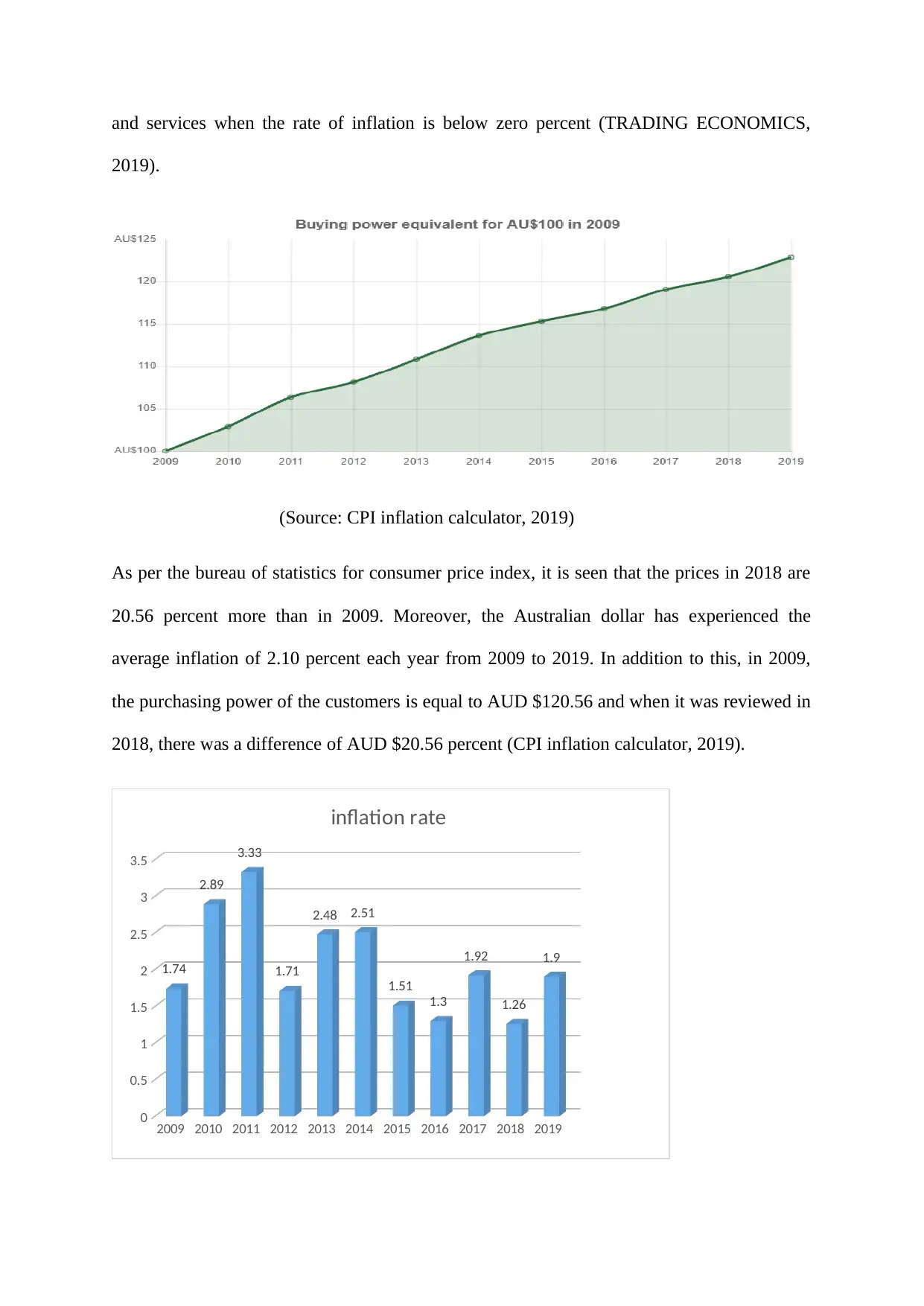
and services when the rate of inflation is below zero percent (TRADING ECONOMICS,
2019).
(Source: CPI inflation calculator, 2019)
As per the bureau of statistics for consumer price index, it is seen that the prices in 2018 are
20.56 percent more than in 2009. Moreover, the Australian dollar has experienced the
average inflation of 2.10 percent each year from 2009 to 2019. In addition to this, in 2009,
the purchasing power of the customers is equal to AUD $120.56 and when it was reviewed in
2018, there was a difference of AUD $20.56 percent (CPI inflation calculator, 2019).
2009 2010 2011 2012 2013 2014 2015 2016 2017 2018 2019
0
0.5
1
1.5
2
2.5
3
3.5
1.74
2.89
3.33
1.71
2.48 2.51
1.51
1.3
1.92
1.26
1.9
inflation rate
2019).
(Source: CPI inflation calculator, 2019)
As per the bureau of statistics for consumer price index, it is seen that the prices in 2018 are
20.56 percent more than in 2009. Moreover, the Australian dollar has experienced the
average inflation of 2.10 percent each year from 2009 to 2019. In addition to this, in 2009,
the purchasing power of the customers is equal to AUD $120.56 and when it was reviewed in
2018, there was a difference of AUD $20.56 percent (CPI inflation calculator, 2019).
2009 2010 2011 2012 2013 2014 2015 2016 2017 2018 2019
0
0.5
1
1.5
2
2.5
3
3.5
1.74
2.89
3.33
1.71
2.48 2.51
1.51
1.3
1.92
1.26
1.9
inflation rate
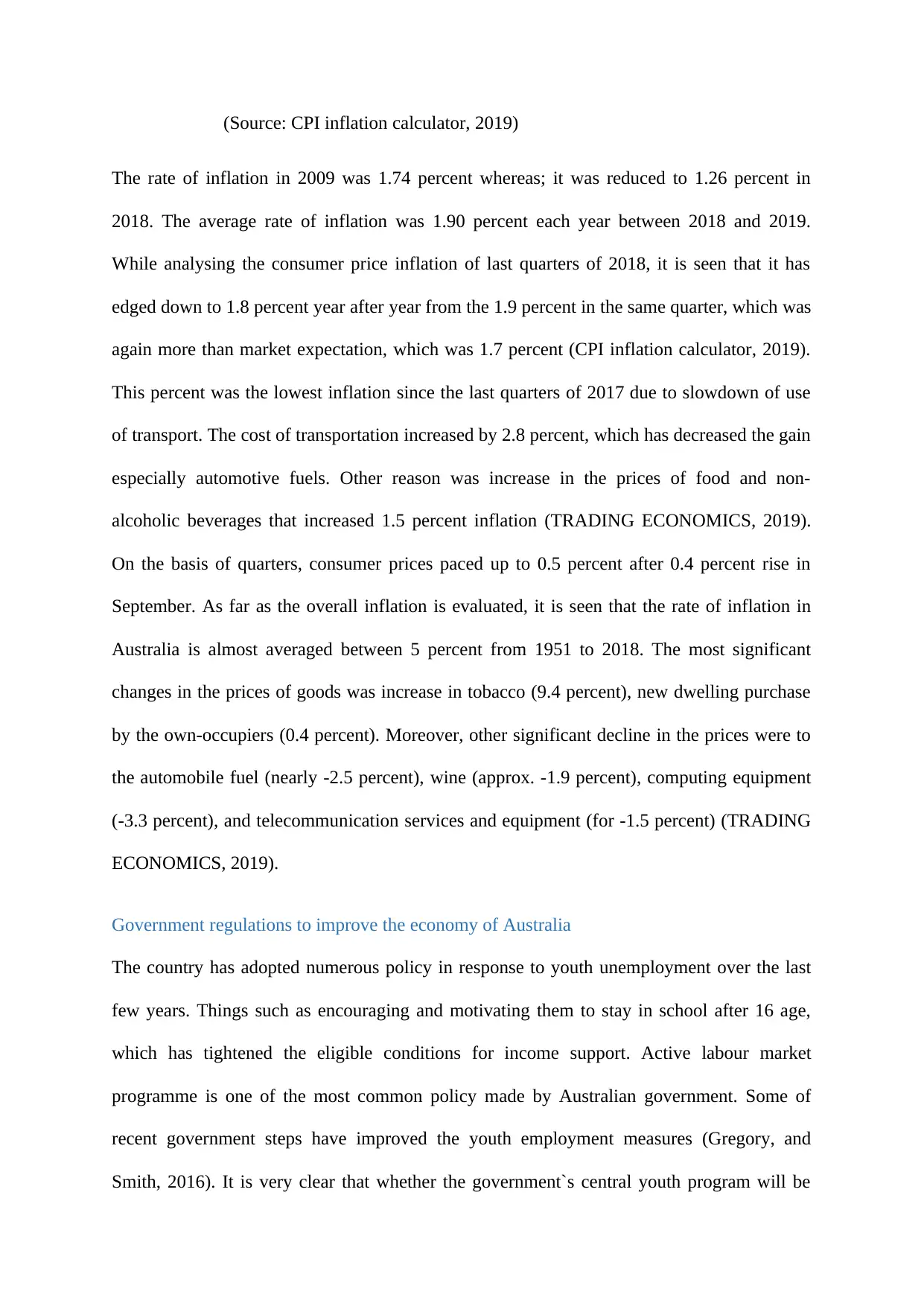
(Source: CPI inflation calculator, 2019)
The rate of inflation in 2009 was 1.74 percent whereas; it was reduced to 1.26 percent in
2018. The average rate of inflation was 1.90 percent each year between 2018 and 2019.
While analysing the consumer price inflation of last quarters of 2018, it is seen that it has
edged down to 1.8 percent year after year from the 1.9 percent in the same quarter, which was
again more than market expectation, which was 1.7 percent (CPI inflation calculator, 2019).
This percent was the lowest inflation since the last quarters of 2017 due to slowdown of use
of transport. The cost of transportation increased by 2.8 percent, which has decreased the gain
especially automotive fuels. Other reason was increase in the prices of food and non-
alcoholic beverages that increased 1.5 percent inflation (TRADING ECONOMICS, 2019).
On the basis of quarters, consumer prices paced up to 0.5 percent after 0.4 percent rise in
September. As far as the overall inflation is evaluated, it is seen that the rate of inflation in
Australia is almost averaged between 5 percent from 1951 to 2018. The most significant
changes in the prices of goods was increase in tobacco (9.4 percent), new dwelling purchase
by the own-occupiers (0.4 percent). Moreover, other significant decline in the prices were to
the automobile fuel (nearly -2.5 percent), wine (approx. -1.9 percent), computing equipment
(-3.3 percent), and telecommunication services and equipment (for -1.5 percent) (TRADING
ECONOMICS, 2019).
Government regulations to improve the economy of Australia
The country has adopted numerous policy in response to youth unemployment over the last
few years. Things such as encouraging and motivating them to stay in school after 16 age,
which has tightened the eligible conditions for income support. Active labour market
programme is one of the most common policy made by Australian government. Some of
recent government steps have improved the youth employment measures (Gregory, and
Smith, 2016). It is very clear that whether the government`s central youth program will be
The rate of inflation in 2009 was 1.74 percent whereas; it was reduced to 1.26 percent in
2018. The average rate of inflation was 1.90 percent each year between 2018 and 2019.
While analysing the consumer price inflation of last quarters of 2018, it is seen that it has
edged down to 1.8 percent year after year from the 1.9 percent in the same quarter, which was
again more than market expectation, which was 1.7 percent (CPI inflation calculator, 2019).
This percent was the lowest inflation since the last quarters of 2017 due to slowdown of use
of transport. The cost of transportation increased by 2.8 percent, which has decreased the gain
especially automotive fuels. Other reason was increase in the prices of food and non-
alcoholic beverages that increased 1.5 percent inflation (TRADING ECONOMICS, 2019).
On the basis of quarters, consumer prices paced up to 0.5 percent after 0.4 percent rise in
September. As far as the overall inflation is evaluated, it is seen that the rate of inflation in
Australia is almost averaged between 5 percent from 1951 to 2018. The most significant
changes in the prices of goods was increase in tobacco (9.4 percent), new dwelling purchase
by the own-occupiers (0.4 percent). Moreover, other significant decline in the prices were to
the automobile fuel (nearly -2.5 percent), wine (approx. -1.9 percent), computing equipment
(-3.3 percent), and telecommunication services and equipment (for -1.5 percent) (TRADING
ECONOMICS, 2019).
Government regulations to improve the economy of Australia
The country has adopted numerous policy in response to youth unemployment over the last
few years. Things such as encouraging and motivating them to stay in school after 16 age,
which has tightened the eligible conditions for income support. Active labour market
programme is one of the most common policy made by Australian government. Some of
recent government steps have improved the youth employment measures (Gregory, and
Smith, 2016). It is very clear that whether the government`s central youth program will be
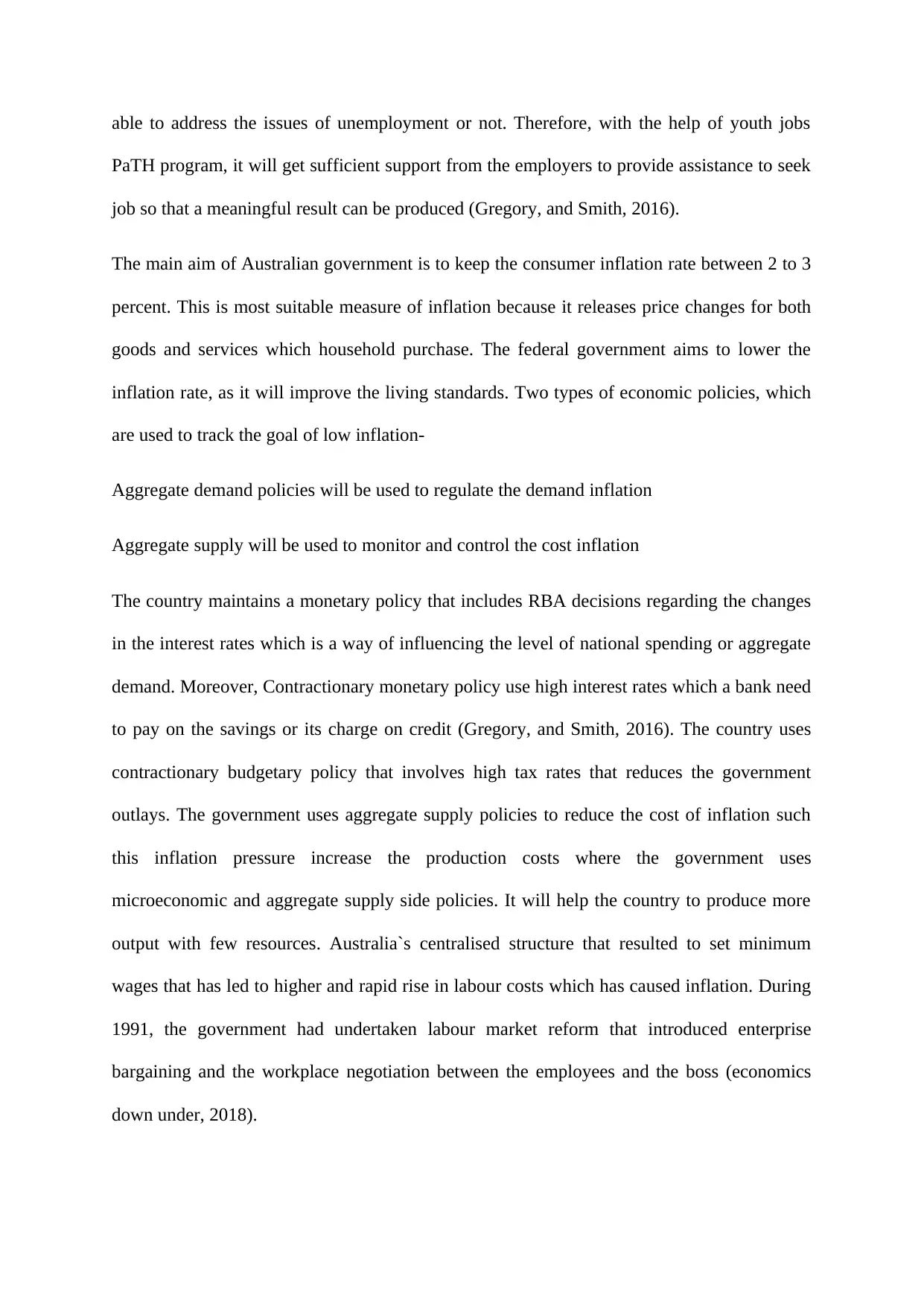
able to address the issues of unemployment or not. Therefore, with the help of youth jobs
PaTH program, it will get sufficient support from the employers to provide assistance to seek
job so that a meaningful result can be produced (Gregory, and Smith, 2016).
The main aim of Australian government is to keep the consumer inflation rate between 2 to 3
percent. This is most suitable measure of inflation because it releases price changes for both
goods and services which household purchase. The federal government aims to lower the
inflation rate, as it will improve the living standards. Two types of economic policies, which
are used to track the goal of low inflation-
Aggregate demand policies will be used to regulate the demand inflation
Aggregate supply will be used to monitor and control the cost inflation
The country maintains a monetary policy that includes RBA decisions regarding the changes
in the interest rates which is a way of influencing the level of national spending or aggregate
demand. Moreover, Contractionary monetary policy use high interest rates which a bank need
to pay on the savings or its charge on credit (Gregory, and Smith, 2016). The country uses
contractionary budgetary policy that involves high tax rates that reduces the government
outlays. The government uses aggregate supply policies to reduce the cost of inflation such
this inflation pressure increase the production costs where the government uses
microeconomic and aggregate supply side policies. It will help the country to produce more
output with few resources. Australia`s centralised structure that resulted to set minimum
wages that has led to higher and rapid rise in labour costs which has caused inflation. During
1991, the government had undertaken labour market reform that introduced enterprise
bargaining and the workplace negotiation between the employees and the boss (economics
down under, 2018).
PaTH program, it will get sufficient support from the employers to provide assistance to seek
job so that a meaningful result can be produced (Gregory, and Smith, 2016).
The main aim of Australian government is to keep the consumer inflation rate between 2 to 3
percent. This is most suitable measure of inflation because it releases price changes for both
goods and services which household purchase. The federal government aims to lower the
inflation rate, as it will improve the living standards. Two types of economic policies, which
are used to track the goal of low inflation-
Aggregate demand policies will be used to regulate the demand inflation
Aggregate supply will be used to monitor and control the cost inflation
The country maintains a monetary policy that includes RBA decisions regarding the changes
in the interest rates which is a way of influencing the level of national spending or aggregate
demand. Moreover, Contractionary monetary policy use high interest rates which a bank need
to pay on the savings or its charge on credit (Gregory, and Smith, 2016). The country uses
contractionary budgetary policy that involves high tax rates that reduces the government
outlays. The government uses aggregate supply policies to reduce the cost of inflation such
this inflation pressure increase the production costs where the government uses
microeconomic and aggregate supply side policies. It will help the country to produce more
output with few resources. Australia`s centralised structure that resulted to set minimum
wages that has led to higher and rapid rise in labour costs which has caused inflation. During
1991, the government had undertaken labour market reform that introduced enterprise
bargaining and the workplace negotiation between the employees and the boss (economics
down under, 2018).
Secure Best Marks with AI Grader
Need help grading? Try our AI Grader for instant feedback on your assignments.

Conclusion
From the above discussion on the economic conditions of Australia, it can be interpreted that
the country is trying hard to improve its economic condition with the help of improvement in
several factors affecting the economy such as employment rate, GDP, and the inflation rate.
From the above evaluation, it can be said that country was largely stuck by the recession in
1990 but it has recovered very soon. There is strong need to promote more employment
initiates to increase the asset base of the country that belongs to people.
From the above discussion on the economic conditions of Australia, it can be interpreted that
the country is trying hard to improve its economic condition with the help of improvement in
several factors affecting the economy such as employment rate, GDP, and the inflation rate.
From the above evaluation, it can be said that country was largely stuck by the recession in
1990 but it has recovered very soon. There is strong need to promote more employment
initiates to increase the asset base of the country that belongs to people.
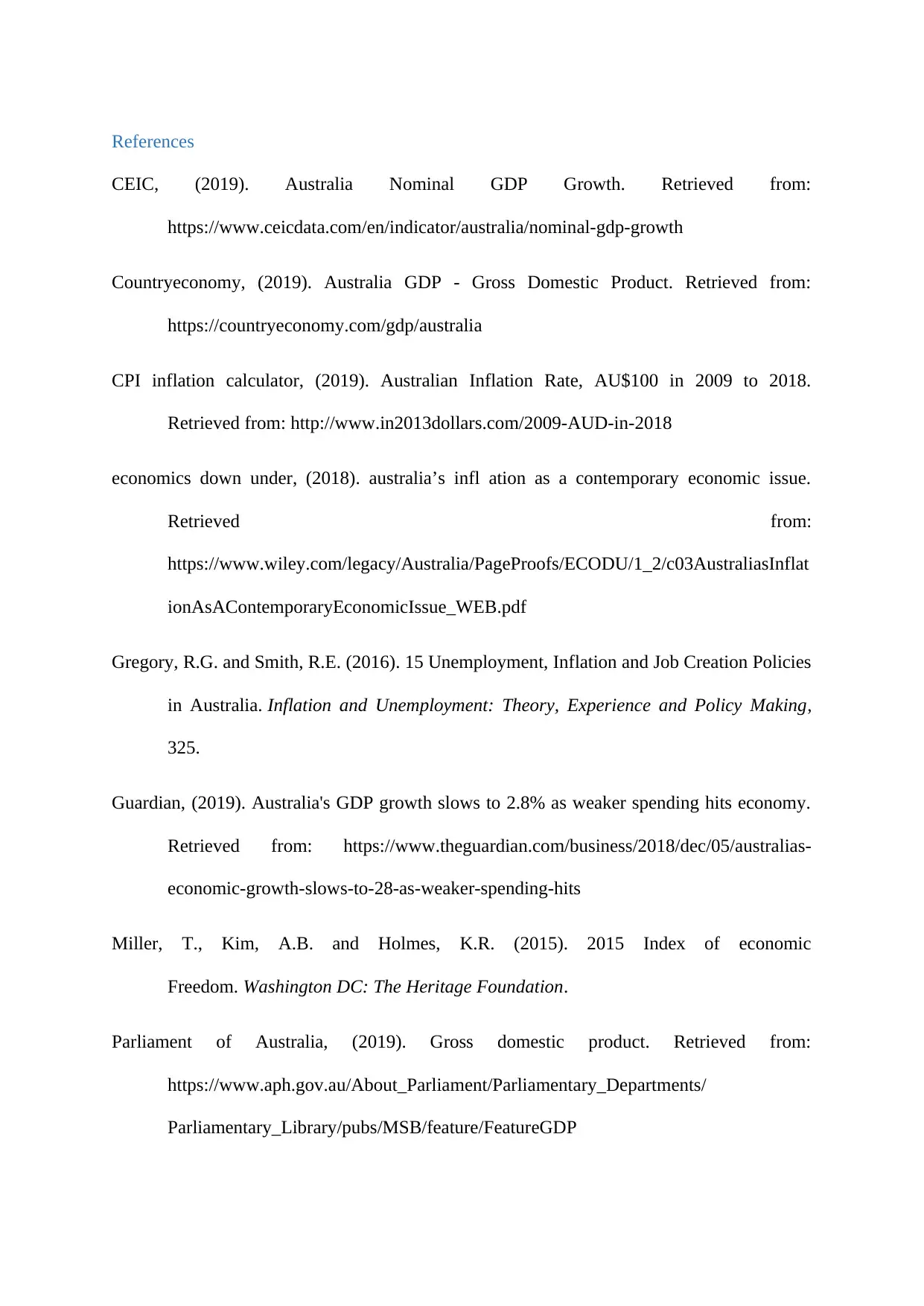
References
CEIC, (2019). Australia Nominal GDP Growth. Retrieved from:
https://www.ceicdata.com/en/indicator/australia/nominal-gdp-growth
Countryeconomy, (2019). Australia GDP - Gross Domestic Product. Retrieved from:
https://countryeconomy.com/gdp/australia
CPI inflation calculator, (2019). Australian Inflation Rate, AU$100 in 2009 to 2018.
Retrieved from: http://www.in2013dollars.com/2009-AUD-in-2018
economics down under, (2018). australia’s infl ation as a contemporary economic issue.
Retrieved from:
https://www.wiley.com/legacy/Australia/PageProofs/ECODU/1_2/c03AustraliasInflat
ionAsAContemporaryEconomicIssue_WEB.pdf
Gregory, R.G. and Smith, R.E. (2016). 15 Unemployment, Inflation and Job Creation Policies
in Australia. Inflation and Unemployment: Theory, Experience and Policy Making,
325.
Guardian, (2019). Australia's GDP growth slows to 2.8% as weaker spending hits economy.
Retrieved from: https://www.theguardian.com/business/2018/dec/05/australias-
economic-growth-slows-to-28-as-weaker-spending-hits
Miller, T., Kim, A.B. and Holmes, K.R. (2015). 2015 Index of economic
Freedom. Washington DC: The Heritage Foundation.
Parliament of Australia, (2019). Gross domestic product. Retrieved from:
https://www.aph.gov.au/About_Parliament/Parliamentary_Departments/
Parliamentary_Library/pubs/MSB/feature/FeatureGDP
CEIC, (2019). Australia Nominal GDP Growth. Retrieved from:
https://www.ceicdata.com/en/indicator/australia/nominal-gdp-growth
Countryeconomy, (2019). Australia GDP - Gross Domestic Product. Retrieved from:
https://countryeconomy.com/gdp/australia
CPI inflation calculator, (2019). Australian Inflation Rate, AU$100 in 2009 to 2018.
Retrieved from: http://www.in2013dollars.com/2009-AUD-in-2018
economics down under, (2018). australia’s infl ation as a contemporary economic issue.
Retrieved from:
https://www.wiley.com/legacy/Australia/PageProofs/ECODU/1_2/c03AustraliasInflat
ionAsAContemporaryEconomicIssue_WEB.pdf
Gregory, R.G. and Smith, R.E. (2016). 15 Unemployment, Inflation and Job Creation Policies
in Australia. Inflation and Unemployment: Theory, Experience and Policy Making,
325.
Guardian, (2019). Australia's GDP growth slows to 2.8% as weaker spending hits economy.
Retrieved from: https://www.theguardian.com/business/2018/dec/05/australias-
economic-growth-slows-to-28-as-weaker-spending-hits
Miller, T., Kim, A.B. and Holmes, K.R. (2015). 2015 Index of economic
Freedom. Washington DC: The Heritage Foundation.
Parliament of Australia, (2019). Gross domestic product. Retrieved from:
https://www.aph.gov.au/About_Parliament/Parliamentary_Departments/
Parliamentary_Library/pubs/MSB/feature/FeatureGDP
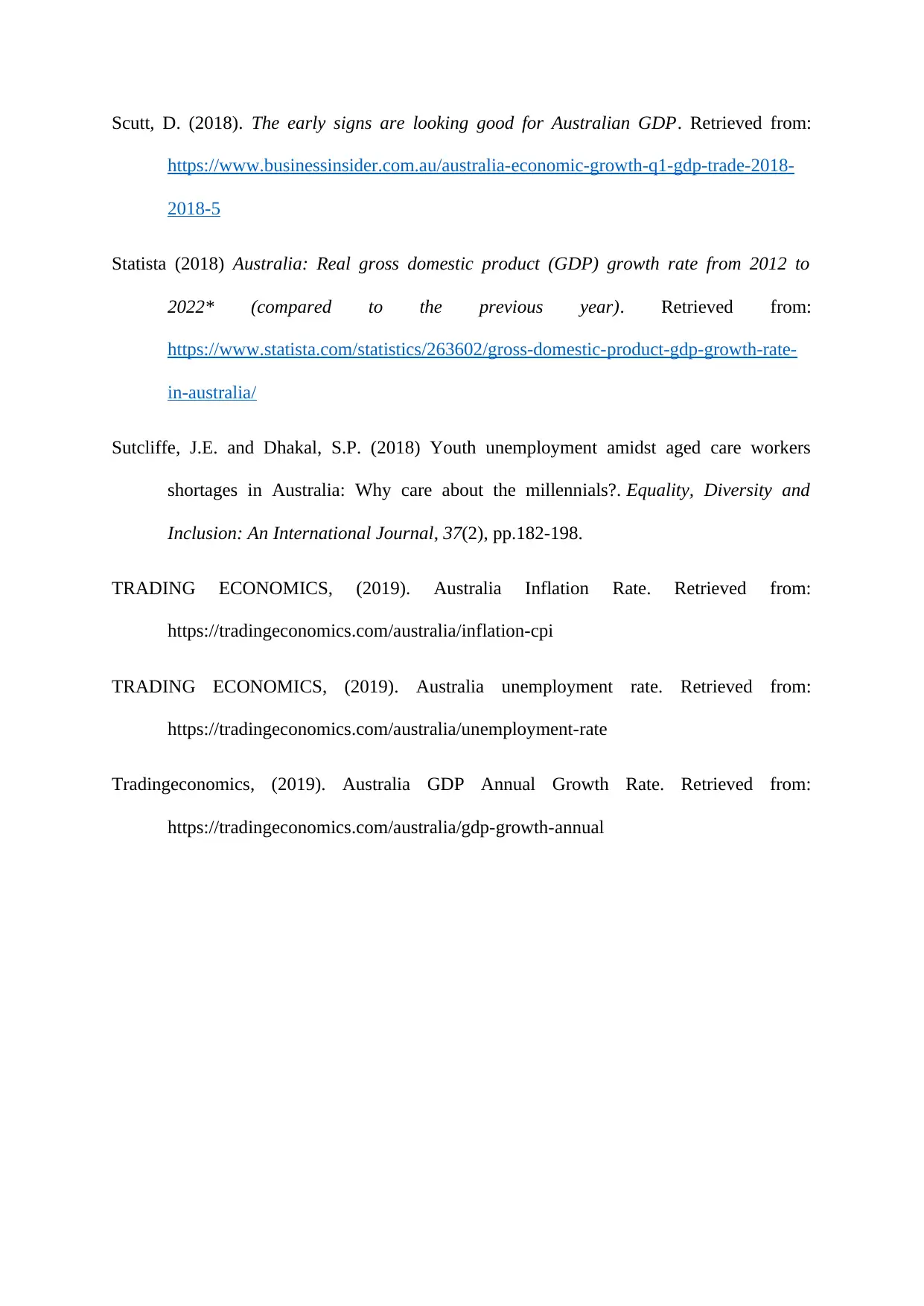
Scutt, D. (2018). The early signs are looking good for Australian GDP. Retrieved from:
https://www.businessinsider.com.au/australia-economic-growth-q1-gdp-trade-2018-
2018-5
Statista (2018) Australia: Real gross domestic product (GDP) growth rate from 2012 to
2022* (compared to the previous year). Retrieved from:
https://www.statista.com/statistics/263602/gross-domestic-product-gdp-growth-rate-
in-australia/
Sutcliffe, J.E. and Dhakal, S.P. (2018) Youth unemployment amidst aged care workers
shortages in Australia: Why care about the millennials?. Equality, Diversity and
Inclusion: An International Journal, 37(2), pp.182-198.
TRADING ECONOMICS, (2019). Australia Inflation Rate. Retrieved from:
https://tradingeconomics.com/australia/inflation-cpi
TRADING ECONOMICS, (2019). Australia unemployment rate. Retrieved from:
https://tradingeconomics.com/australia/unemployment-rate
Tradingeconomics, (2019). Australia GDP Annual Growth Rate. Retrieved from:
https://tradingeconomics.com/australia/gdp-growth-annual
https://www.businessinsider.com.au/australia-economic-growth-q1-gdp-trade-2018-
2018-5
Statista (2018) Australia: Real gross domestic product (GDP) growth rate from 2012 to
2022* (compared to the previous year). Retrieved from:
https://www.statista.com/statistics/263602/gross-domestic-product-gdp-growth-rate-
in-australia/
Sutcliffe, J.E. and Dhakal, S.P. (2018) Youth unemployment amidst aged care workers
shortages in Australia: Why care about the millennials?. Equality, Diversity and
Inclusion: An International Journal, 37(2), pp.182-198.
TRADING ECONOMICS, (2019). Australia Inflation Rate. Retrieved from:
https://tradingeconomics.com/australia/inflation-cpi
TRADING ECONOMICS, (2019). Australia unemployment rate. Retrieved from:
https://tradingeconomics.com/australia/unemployment-rate
Tradingeconomics, (2019). Australia GDP Annual Growth Rate. Retrieved from:
https://tradingeconomics.com/australia/gdp-growth-annual
1 out of 13
Related Documents
Your All-in-One AI-Powered Toolkit for Academic Success.
+13062052269
info@desklib.com
Available 24*7 on WhatsApp / Email
![[object Object]](/_next/static/media/star-bottom.7253800d.svg)
Unlock your academic potential
© 2024 | Zucol Services PVT LTD | All rights reserved.





